Carrot: planting and care, collecting and storage 🥕
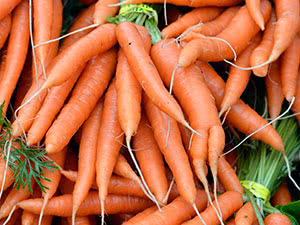 Carrot plant (lat. Daucus) belongs to the genus of flowering plants in the family Apiaceae. The name "carrots" is derived from the Latin language. In the wild, this plant is widespread in Africa, New Zealand, Australia, the USA and the Mediterranean. In agriculture, being a vegetable carrot is presented by the species of domesticated carrot (Daucus sativus) that is subdivided into fodder and table varieties. Carrot has been cultivated for about four thousand years, and during that time many varieties of the plant have been bred. It is believed that the birthplace of carrot is Afghanistan because most of the species of this vegetable are still growing there.
Carrot plant (lat. Daucus) belongs to the genus of flowering plants in the family Apiaceae. The name "carrots" is derived from the Latin language. In the wild, this plant is widespread in Africa, New Zealand, Australia, the USA and the Mediterranean. In agriculture, being a vegetable carrot is presented by the species of domesticated carrot (Daucus sativus) that is subdivided into fodder and table varieties. Carrot has been cultivated for about four thousand years, and during that time many varieties of the plant have been bred. It is believed that the birthplace of carrot is Afghanistan because most of the species of this vegetable are still growing there.
At first, the carrot was not grown as an edible root vegetable but only for its aromatic leaves and seeds. In Europe, the plant was brought in the X-XIII centuries AD. Records about carrot can be found in The Domostroy meaning that in the XVI century it was grown in Russia.
Description of the carrot plant
Carrot is an annual, biennial or perennial herbaceous plant that in the first year of growth forms a rosette of pinnate leaves and root, and in the second year it forms seeds. The form of taproot is truncated conical, cylindrical or spindle-shaped. It is fleshy and weighs from 1 to 18 oz and more. The inflorescence is a compound umbel with 10-15 umbellets with small, white, yellowish or reddish flowers and a red flower in the center. The seed is a small elliptical diachenium up to 1.5 inch long. The root contains carotene, lycopene, vitamin B, flavonoids, anthocyanidins, sugars, ascorbic and pantothenic acids, and other substances that are necessary for human health.
Carrot planting in open ground
When to plant carrot in the soil
Carrot seeds germinate at the soil temperatures of 39-43 ºF, therefore they can be sown as soon as the ground gets warmed to this temperature that usually happens by the end of April. Late and middle season varieties of carrot can be sown after the 20th of April until the first week of May inclusive. If the soil is medium, carrot can be sown in the second week of May, and if the soil is light, the carrot can be sown up to the end of the month. Being in the soil the seeds are not afraid of freezing at the temperature of 28º F. It is better to plant carrot before heavy rains. Try not to be late with the sowing, otherwise the seeds will germinate for very long time.
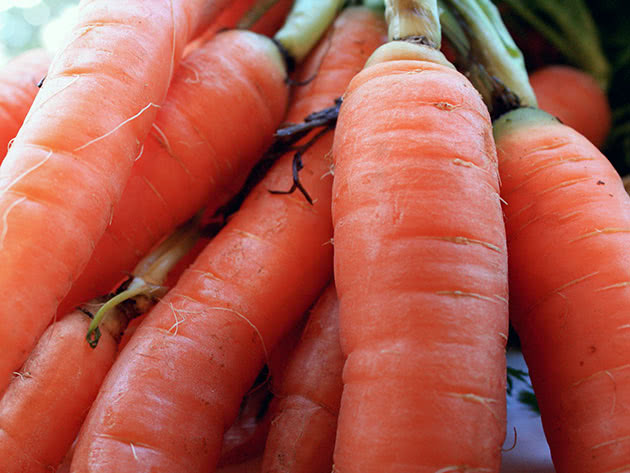
The soil for carrot
The place for the carrot should be well sunlit and even, but a slight slope area is appropriate as well. You should avoid beds for carrot where cumin, fennel, parsley, parsnip, dill, beans and carrots grew last year, as these vegetables quickly absorb micro and macro elements from the soil, impoverishing it, and it is likely that carrot harvest will be poor. At least three years should pass before you can plan carrot after such predecessors. Instead carrot grows well after potato, cucumber, squash, cabbage, tomato, garlic or onions.
Once the site is chosen, it is necessary to prepare the soil for carrot: for spring planting you should dig over the soil beforehand in autumn so that the soil will have enough time to get settled until spring. Digging is carried out to a depth of one and a half shovel spade, so that if a root goes well in growth and sets against a tight and not well dug layer of soil, it will not get through it, change direction and get curved. It will be very difficult to dig out such a carrot.

Before carrot planting, you need to add a fertilizer to the soil. It is applied at such rate: 0.8-1 oz of superphosphate, 0.5 oz of potassium fertilizer, 0.5-0.7 oz of nitrogen fertilizer and 4.4-6.6 pounds of humus per 11 ft². Then the soil is dug up and left until spring. You will only need to rake the site in spring.
How to plant carrot in the open ground
Growing carrot from seeds begins with the preparation of the seed grains. Before carrot planting seeds must be processed to increase their germination. There are four ways of presowing preparation of seeds:
- they are soaked for 24 hours in warm water (86 ºF), changing it at least six times. Instead of water, you can prepare a nutrient solution of the same temperature by dissolving a tablespoon of ash in 1.8 pint of warm water. After this treatment, rinse the seeds with a clean water, wrap it in a cloth and place in the refrigerator for several days;
- seeds are placed in bag made of cloth and immersed in water at 122 ºF for 20 minutes, then cooled in cold water for 2-3 minutes;
- seeds are placed in a bag made of cloth and buried for 10 days in the ground to a depth of bayonet spade;
- if you have a bubbler, you can carry out the bubbling of seeds: keep them in an oxygenated solution of a plant biostimulant for 18-20 hours.

After being treated by any of these methods, the seeds are ready for planting. Carrot planting in the soil is carried out at a depth of 0.8-1.2 inches if the soil is light. If the soil is heavy, then the depth should be smaller - about 0.6-0.8 inch. The distance between rows should be about 8 inches. The seeds are sown 1.2-1.6 inches apart. There is a tip from Eastern Europe how to keep this distance: you can use pre-cut narrow strips of soft paper, put drops of a flour paste 1.2-1.6 inches apart and place carrot seeds into these drops. When the paste gets dried, the tape is folded in half, and then rolled. When it is time to sow, a tape is unfolded and put in a well-moistened furrow. After sowing the seeds, the site is mulched to a depth of 1.2 inches, so that there will be no crust on the soil surface that will make it difficult for the seedlings to germinate. There is another way to sow carrot: paper towels or toilet paper are cut into small squares, a drop of flour paste is put on each piece of paper, one or two seeds and a grain of compound mineral fertilizer are placed into a drop of flour paste, each piece of paper is rolled up into balls, let them dry and store until planting. These balls are placed in the furrow with the needed interval of 1.2-1.6 inches.
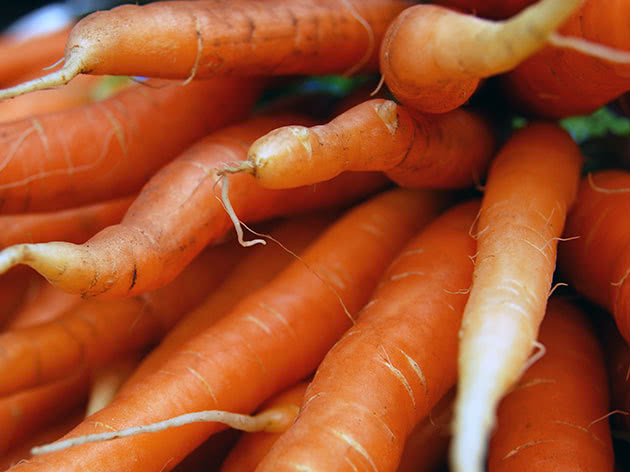
Carrot planting before winter
When planting of winter carrot, you will receive harvest two weeks earlier than with spring sowing, but in autumn you should sow early varieties that are not stored for a long time. This should be done in late October or early November, and the beds for carrot are prepared three weeks before planting. After sowing the seeds, the soil is mulched to the depth of 1.2 inches. In spring the site is covered with a foil that is kept until the seedlings appear. Autumn carrot planting in soil is carried out only in light soil.
Care for carrot
How to grow carrot
Growing carrot in the open ground involves thinning of seedlings when they grow too densely, frequent loosening and removing weeds that can cause certain diseases, and regular watering of carrot. The first thinning is carried out when seedlings have developed the first two true leaves. After thinning the distance between the seedlings should be 0.8-1.2 inches. When the second pair of leaves appear, the seedlings are thinned out for the second time, doubling the distance between them. If you used paper tape or balls, then there is no need to thin the seedlings. Weeding is done at the same time with thinning, and it is better to do this after irrigation, when the soil is moist.

Watering of carrot
If you want to grow big, juicy, sweet root vegetables, you need to know how to water the carrot. Insufficient irrigation can cause withering and bitter taste of vegetables. Watering of carrot is the most important point of care for the plant during all its stages of development. Depth of humidification should correspond to the size of root, ie, the land must be moist to a depth of at least 12 inches. Lack of humidification provokes the appearance of lateral roots that grow in search of moisture source. This spoils not only the appearance of carrot, but its taste qualities - pulp turns coarse and stiff. Excessive moisture is the cause of cracking of roots, they get covered with small shoots, increasing the growth of foliage. Usually carrot is watered about once a week in this volume:
- the first time after sowing soil is watered at the rate of 5 pints per 3.3 feet;
- after the second thinning of seedlings the amount of water is increased up to 17.6 pints of water per 3.3 feet;
- when after the leaves the growth of root begins, the amount of water should be in the range of 35 pints per 11 ft²;
- 1.5-2 months before harvesting, carrot is watered once a week and a half or once every two weeks with the amount of water about 17.6 pints per 3.3 feet, and two or three weeks before harvesting watering should be ceased at all.

Feeding of carrot
During vegetation period fertilizing of carrot is performed twice - the first time is in a month after the appearance of shoots, the second time is in two months. What fertilizers are applied? Liquid fertilizers are applied consisting of the following: two cups of wood ash, a tablespoon of nitrophosphate, 0.7 oz of potassium nitrate and 0.5 oz of superphosphate and urea per 1 bucket of water. Fertilizers are applied after preliminary watering of carrot.
Carrot treatment
You will read what diseases carrot has and how to treat carrot in the next section.
Pests and diseases of carrot
Diseases of carrot
Carrots are susceptible to diseases and pests, and to avoid massive damage of roots, it is necessary to know how to treat the carrot in each case. The diseases that can seriously harm carrot are brown rot, carrot bacteriosis, leaf spot, watery soft rot, sclerotinia rot, violet root rot and black rot. Carrot bacteriosis is spread through seeds and infected plant remains, so remove the carrot tops from the garden after harvest, and before being sown the seeds should be processed by hot (125 ºF) water. Sclerotinia rot and watery soft rot affect almost all vegetables. These fungal diseases occur more often during storage. To avoid contamination, acidic soil should be limed, do not overuse the nitrogen fertilizers, remove the weeds from the site and before storing roots should be dusted with chalk. It is important to follow the rules of storage of roots and ensure good ventilation in the storeroom.

Violet root rot manifests itself by appearance of brown or purple spots on the roots, then the spots disappear, and black sclerotia of the fungus take their place. This disease affects not only a carrot but also swede, turnip, parsley, beets and other root crops. The appliance of manure as a fertilizer provokes disease. The roots that are infected by violet root rot should be stored separately from the rest of carrots. Black rot looks like a coal-black rotten patches on the roots, it is the most dangerous for the carrot’s seeds. The diseased plants must be removed immediately. As a preventive measure, before being sown the carrot seeds should be treated with a fungicide.
Leaf spot manifests itself by small chlorotic spots on the carrot leaves that eventually turn brown with a red rim. Under conditions of high humidity the disease is able to spread very quickly. When the first signs appear, the site is processed by one percent Bordeaux mixture several times at intervals of 10 days. Strongly affected plants have to be removed from the site and destroyed, as well as crop remains after harvest. As a preventive measure, before being sown seeds should be processed with hot water and then sharply cooled. And do not forget to apply phosphorus-potassium fertilizer. Brown rot affects stems of testes and inflorescence of carrots, then on the top of the root brown spots are formed, gradually deepening and affecting the entire root. Light soils promote the development of the disease. As a preventative measure, before being sown the seeds need to be treated with a fungicide and affected plants must be removed immediately.

Pests of carrots
The pests that are dangerous for carrot are carrot fly, winter cutworm, wireworms and slugs. To get rid of slugs you can collect them manually, but if the invasion is massive, beer cans are digged into the soil as the smell of beer attracts slugs, or place several pieces of pumpkin or watermelon that will gather a decent amount of slugs in the morning. To scare off gastropods from carrots, you can sprinkle powdered superphosphate, ash or pine needles over the site. Wireworms, or larvae of wireworms, affect not only cattor but also cabbage, cucumbers, tomatoes, celery, potatoes and strawberries. The beetle is up to 0.4 inch long, black-brown with reddish elytra and its female is able to lay up to two hundred eggs in one set. The larvae are yellow-brown of cylindrical shape, up to 1.6 inches long, and get developed in 3-5 years. To get rid of pests small holes are dug out in the site, then half-rotted grass, pieces of raw potato or of any other root vegetable are placed in the holes, sprinkle the holes with soil and mark the place with a stick. In a few days, the hole is dug out and gathered larvae are destroyed. Winter cutworms damage the carrot parts that are under the ground and gnaw the roots and stems. In addition to carrots, the victims of caterpillars become kohlrabi, tomatoes, beets, parsley, cucumbers, onions and potatoes. Insecticides destroy caterpillars. Onions that are planted between the rows of carrots distract the carrot flies.

Collecting and storage of carrot
Carrot harvesting is carried out in several stages. First, you can start collecting it in summer for a meal, and keep other roots in the ground for them to get more resources and gain more weight. Then early varieties of carrots that ripe in July are harvested. In August it is time to harvest mid season carrots; and late varieties, intended for long-term storage, are dug out from the middle till the end of September. When to dig up carrot? It is better to do it in a warm and dry day. From light soil the roots are pulled out by grasping the top and from heavy soil carrot is necessary to dig up with a shovel. After collecting the carrot, it is sorted out, putting aside the damaged roots for processing. If the carrot is appropriate for storing, the leaves are cut off at their base, put the roots under the shed to dry for a few days and then place them in the storeroom.

You can find the ways how to store carrot in the special Article that details how to store carrots, beets and other vegetables in winter. It is better to store carrots in the basement or cellar in wooden or plastic boxes. The roots should be mixed with the sand and they should not be contiguous. Instead of sand, you can use the moss, or crushed chalk and onion peel as chalk and peel onions counteract the development of putrefactive processes.
There is another way to store carrot by clay glazing. The clay should be diluted with water to a density of sour cream, then every root is dipped into the mash, put it on the grill to dry, and then gently placed into the cellar. If you store the carrot in a clay shell at a temperature of about 32 ºF in a dry cellar, it will stay juicy and fresh until spring.

Species and varieties of carrot
Against our expectations, the carrot can be not only red and of a conical shape. The carrot got the orange color only in the XVII century, before that, for example, white carrots were grown in the Roman Empire, purple carrots were grown in ancient Egypt, and even black carrots were grown in some countries of Western Europe. In the early paintings of Dutch artists purple and yellow roots were depicted. The first orange carrot was very pale, since it contained carotene 3-4 times less than modern varieties of carrots. Quite recently, in 2002, breeders revived the varieties of purple carrots that can be already found in the shops. Besides varieties of purple carrot, purple pigments of anthocyanidins can be found in such plants as purple basil, beets and red cabbage. They improve brain function and cardiovascular system, purifying blood from cholesterol and fat. Breeders also work on the shape and dimensions of root crops, that are now presented by varieties of such shapes as conical, almost round, pointed, spindle or with a rounded tip. A huge number of varieties of carrots are divided into types the mainest of which are:
- Paris Karotel is a very early, tender, sweet and round, like radishes, carrot 1.6 inches in diametre. It produces good yields even on weak or clay soils;
- Amsterdam is a cylindrically shaped root 0.8-1 inch in diameter, 6-7 inches long, with a rounded tip. It is juicy, sweet, soft and with a small core. The only disadvantage is their fragility: if carelessly collected, the roots can be easily broken. It is an early season type, not intended for storage;
- Nantes is a cylindrically shaped root 1.2-1.6 inches in diameter, up to 9 inches long, with a rounded tip and it has a sweet and juicy flesh. It is suitable for food in summer and storage;
- Berlicum-Nantes also has a cylindrical shape, but with a sharp tip, as well as it is larger than Nantes. Keeping qualities of this type are great, but it is not as tasty as above mentioned type;
- Imperator is a conically shaped root up to10 inches long with a sharp tip. Varieties of this type are very different in taste (some of them are very sweet and some of them are not sweet at all), the degree of keeping qualities and the fragility ( some of them can get broken when carelessly handled);
- Flakker is the most productive and longest, reaching 12 inches in length. The weight of one root can be 1 pound and more. The growing season of this type is very long, it is well stored, but, unfortunately, it does not have the same high taste qualities as Nantes and Amsterdam have.
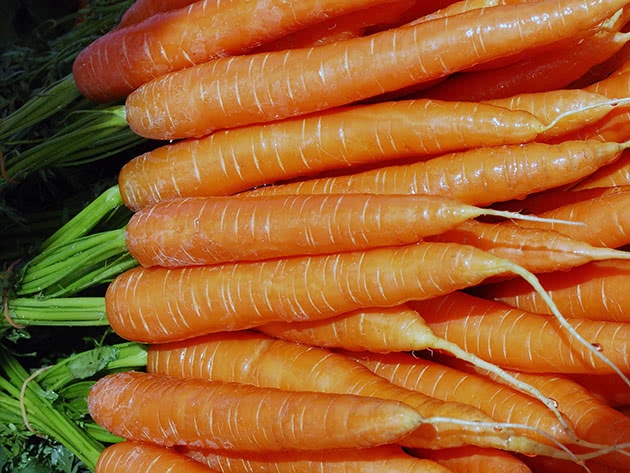
Carrot varieties for open ground are also divided according to the purposes of cultivation. If you are a lover of exotic, then you will enjoy these varieties:
- F1 Purple Elixir is the roots the surface of which has a rich violet color with a purple hue, but inside they are of usual orange color. The length of the root is about 8 inches. This carrot is used for pickling and salads;
- Russian Size belongs to the Imperator type and it is famous for its size. In light soils it reaches 12 inches in length and sometimes it weighs about 2.2 pounds. Despite the fact that these dimensions are more suitable for feeding carrot, pulp of this carrot is sweet and juicy, the core is small, and the color is bright orange;
- Polar Cranberry belongs to Paris Karotel type resembling a known berry by its almost circular shape and it contains a high amount of dry matter and sugars. It is very convenient for the preservation and storage;
- Minicore is an early season type of Amsterdam variety. The root is juicy, miniature, cylindrical, 5-6 inches long, with a delicate flavor. Carrots of this type are very convenient for preserving of whole roots.
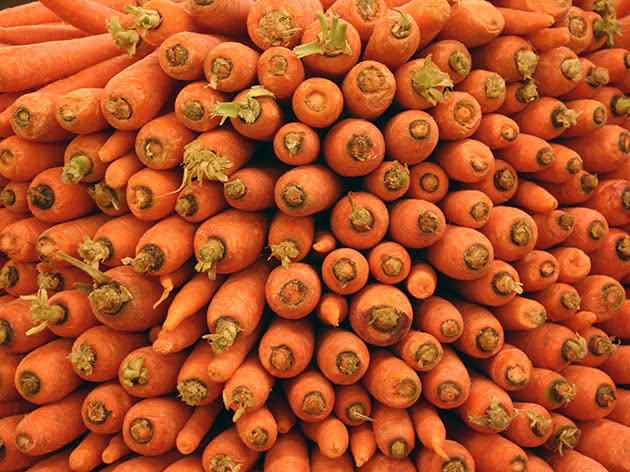
For those gardeners who are interested in taste qualities of the product, in the amount of useful nutrients, and not in the carrot appearance, more suitable varieties are:
- Healthmaster is a new variety of Flakker type containing beta-carotene at least a third more than any other variety. The surface of the root is smooth, crimson-red, the core has even more saturated color, the average length is about 9 inches;
- Sugar Gourmet is a hybrid of Imperator type, up to 10 inches long, of deep orange color with a small core and smooth surface;
- Praline is a variety of Nantes type with a high content of carotene, almost without a core, of red-orange color, 8 inches long. Taste qualities of carrots are beyond praise. It is very sweet, tender and juicy;
- Losinoostrovskaya 13 is a mid season variety, 6-7 inches long, has a good keeping quality.

If you are a pragmatic person and you do not have time for garden experiments, we offer you the list of varieties that are resistant to disease, productive and well-kept in winter:
- Samson is a middle season high yield variety of Nantes type with bright orange cylindrical root and with a juicy, sweet, crisp flesh;
- Mo is a late-season and high yielding variety of Imperator type with conical juicy bright orange root up to 8 inches long, perfectly stored in winter;
- Flakker is a mid season variety of spindle-shape with subtle eyes, capable of producing high yields even in heavy soils. Roots reach a length of 12 inches;
- Forte belongs to Nantes type. It is a mid-season variety with smooth cylindrical roots of excellent taste 7-8 inches in length. It produces a stable high yield and it is well stored.
Carrot is classified into groups based on its maturity terms. The first one is an early season variety, or precocious, that matures in 85-100 days. The second group is a mid season variety that matures within 105-120 days. And there are late season varieties that need around 125 day to ripen. Among early varieties of carrots well established varieties are Alenka, Belgian White, Dragon, Fun, Bangor, Kinbi, Colour, Laguna and Touchon. Mid season varieties are Vitamins, Altair, Viking, Callisto, Canada, Leander, Olympian and Royal Chantenay. Late season varieties are Autumn Queen, Vita Longa, Yellowstone, Selecta, Perfection, Totem, Ting, Olympus, Skarla.
